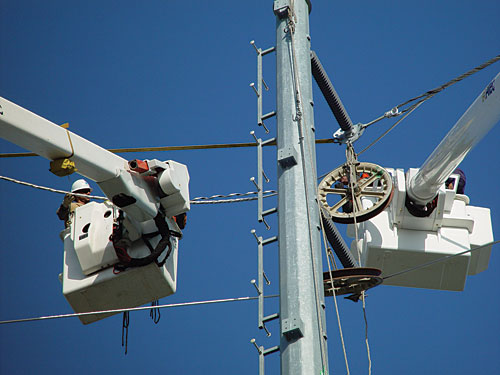MISO Transmission Benefits Analysis is here!!!
March 4th, 2007
I know you’ve been sitting on the edge of your chair waiting for this — well, wait no more!
Why care about the MISO Transmission Benefits Analysis? Because it tells us just what they’re going to get if they build the CapX2020 transmission megaboondoggle!  Well, not specifics, but enough so that it’s obvious to somebody that doesn’t know the difference between AC$R, AC$$, and ACCR!
STrib – “wind transmission” NOT
March 4th, 2007
Here I just got that post done, and what comes in but the STrib article with more whining about transmission. Note he’s quoting Mark Ahlstrom, WindLogics, but hey, WindLogics is a contractor that put together the Minnesota Wind Integration Study, which shows that through distributed and dispersed generation we can site 5,000-6,000MW around the state without a significant infrastructure investment — WE DON’T NEED TRANSMISSION TO BUILD WIND, WE DON’T NEED TRANSMISSION TO FULFILL THE RES!
So next time they say we need transmission — you know better!!! It’s not for wind — the CapX2020 transmission is for coal from the Dakotas.
Here’s the STrib article:
Last update: March 03, 2007 – 10:16 PM
Green dreams of wind energy face a fickle future
The state is empowering the wind-turbine industry to crank up its efforts. But creating the electricity may prove to beeasier than distributing it.
By Mike Meyers, Star Tribune
FENTON TOWNSHIP, MINN — When Gov. Tim Pawlenty signed a landmark “green energy” bill 10 days ago, the crews here on Buffalo Ridge, their eyebrows glazed with ice, were being battered by some of the wildest winds in the Midwest.
Their work on the prairie erecting a sprawling forest of wind turbines, each soaring 26 stories, is one of the simpler feats needed to make Pawlenty’s vision for the state’s energy future come true: drawing 25 percent of Minnesota’s electricity from renewable sources by 2025.
Reaching that benchmark would cement the state’s position as a national leader in wind power. But getting there will be anything but a breeze.
Raising money, negotiating land rights, gaining permits and doing the construction can take years. And before wind parks are built, investors must know that transmission lines will deliver the power to buyers.
Transmission line operators, meanwhile, must learn how to accept a volatile source of power without destabilizing the electrical grid.
It’s not impossible,” said Dale Osborn, transmission technical director for the Midwest Independent Transmission System Operator (MISO), which orchestrates distribution of power among 15 states and one Canadian province. “But there are going to be challenges that are very formidable, and they have to be resolved.”
Only three states — California, Texas and Iowa — produce more wind-generated electricity than Minnesota. The stroke of Pawlenty’s pen will lend more momentum to what already was a rush of investment on wind and other green power projects.
To reach a U.S. goal of 20 percent of electricity coming from wind power, nationwide investment will have to total $30 billion a year this decade and next, by the estimate of the Wind Energy Association.
Consider the harsh realities
The latest project in southwest Minnesota is owned by EnXco, based in North Palm Springs, Calif. A visit to the $300-million wind park under construction shows some of the cold realities Minnesota faces in its energy future.
“Climbing a ladder [260 feet] to tighten bolts, that’s hard work. It’s physical torture,” said Warren Grieves, director of the construction project. Grieves, 64, has scaled those hundreds of rungs himself several times, and he starts every day with leg-stamina exercises, in case today’s the day he has to make another climb.
Spanning a stretch of farm fields 7 miles long and 7 miles wide, the wind park will add 200 megawatts of wind-power capacity by year’s end.
To reach that goal, crews will have to pour 25 trucks of concrete, lift a tower that weighs 125,000 pounds, a turbine that weighs as much as the tower; a hub, 38,000 pounds, and a rotor, 79,000 pounds.
Then repeat the whole process, 137 times.
Over the next 18 years, crews working for a host of companies will brave the elements to deliver 25 times that additional power, maybe more.
Just negotiating with farmers to plant wind turbines in their fields of corn, soybean and alfalfa can take years. About 160 people had to sign deals before EnXco could break ground on its latest project.
Simply coordinating the delivery of parts also is a tough task, as suppliers strain to keep up with new demand. Some of the rotor blades on the turbines going up in southwest Minnesota were shipped from Brazil.
Sitting in his warm St. Paul office, 250 miles from the wind-swept construction site, Osborn is one of a small army of engineers who soon will have to juggle the distribution of energy from the new wind park and scores of others springing up across the Midwest.
About 1,000 megawatts of wind power are produced in Minnesota today, enough energy for about 400,000 homes.
Asked to size up the task of adding up to 6,000 megawatts of wind-powered electricity to the Minnesota grid over the next 18 years, Osborn makes it clear that heavy lifting is ahead.
“It probably takes seven years or more to build a line that will carry that power,” he said. “Currently, a lot of areas don’t have any capacity left.”
The volatile, unpredictable nature of wind is another problem. A recent study showed that in the summer, when winds tend to blow slower than in the other three seasons, 86 percent of the potential electrical capacity of wind turbines will be idle.
“Wind is like having a car that’s out of fuel when you need it the most,” Osborn said.
Engineers will have to figure out ways to integrate wind power into the electrical grid without counting on it to meet peak demand in summer.
“You’ve got to get to market somehow, don’t you?” said Jim Alders, Xcel Energy manager of regulatory projects. He noted that the last major transmission projects in Minnesota date from the 1970s.
Permit process a challenge
Mark Ahlstrom, chief executive of St. Paul-based WindLogics, said untangling electrical power bottlenecks will overshadow the challenge of building wind parks.
“We can build a wind plant in two years,” he said. “It can take seven years or more to get a transmission line permitted and built, even in the best of cases.”
The control center, which operates around the clock, not only monitors EnXco’s Minnesota operations, but 23 other power parks, scattered from California to New Jersey.
Windmills can operate at 30 degrees below zero, but ice can rob their rotors of efficiency. No matter when a turbine fails, it must be fixed immediately. “When the machines got to be over $1 million, it doesn’t pay to let them be down at night,” said Randy Grayson, EnXco’s area operations manager.
Maintenance crews work at all hours in all weather, sometimes to the chagrin of their families. The workers have a nickname for a wind turbine: “We call it, ‘The other woman,’ ” Grayson said.
Will EnXco’s power find its way into the grid?
Xcel’s short-term solution to the transmission issue is a $300 million project, already underway, to add high-power lines around southwest Minnesota.
Longer-term, the utility plans to spend $700 million stringing 600 miles of transmission lines across various parts of the state.
Finishing the job will take the rest of this decade and most of the next, because the sprawling wind park in Fenton township likely will have to be duplicated two dozen more times.
“We don’t have all the answers now,” Alders said.
Mike Meyers • 612-673-1746 • meyers@startribune.com
“More heat, less sag”
March 4th, 2007
Yup, more heat, less sag, that’s something we all need, the industry fix for “50’s vintage conductors” and maybe it’s better than bag balm! With Capx2020 coming up, and with the Chisago line underway, I’ve got transmission on the brain, and you know they can’t build coal without transmission.

Back in the SW MN 345kV case, the “it’s for wind” NOT line, I’d subpoeaned 3M about its new conductor, probably spring of 2002, because Xcel was planning a high capacity line and I knew this ACCR composite conductor was coming down the pike. Both 3M and Xcel said they weren’t going to use it, and Xcel entered exhibits and testified about it — nope, they were NOT going to use it. Instead, they were going to use a high capacity ACSS:
ACSS – 345kV bundled 954 = 2085MVA
So now how about these CzpX2020 lines “from the coal fields” through Minnesota to Wicsonsin and points east?

Will the 2085MVA ACSS be enough or do they want even more to put even more coal on the wires? And there’s the cost to consider, so probably not — they haven’t got a market… but then again, there’s always the Minnesota ratepayers to pay for their bulk power wholesale transactions!
South Dakota has been looking at this market issue, because they’re realizing that they want to build all this coal and they want to build all this transmission, that pesky Minnesota is in the way, but more importantly, they get that there is no market and that they have to look at creating a market. They get that there’s plenty of electricity and I hope they’re getting that it’s not realistic to think that Wisconsin or Illinois would buy their electricity when there’s plenty right at home and without all that added transmission service and construction cost:
South Dakota Energy Infrastructure Authority – Energy Study 2007
SDEIA Electric Industry Interviews Report December 2006
So they get it — there’s a bit of a market problem. Hence the COALition – there’s Wind on the Wires and AWEA and their unsavory promotion of National Transmission Corridor through Minnesota, there’s RE-AMP and they’re working on “finding a way forward for coal.” Check p. 11 of this Executive Summary:
Good idea… let’s bail out the coal industry… real good idea…
But they cannot do it without transmission. And we all know that CapX2020 really isn’t needed, but for this coal for export scheme — and that’s why they want to be excepted from providing the typical need data with their application:
Comments on their outrageous “the rules don’t apply to US” assertions are due March 19, 2007 .
The Comment period has been extended because Xcel/CapX2020 refuses to use the service list and serve parties on it and they were caught. Again. How dare they!!! How many times do I have to remind them? And what’s next, sue them about it — yeah, real effective use of time. But somebody with additional clout gave them what for and, WHEW, it’s extended.
Now about these high-capacity conductors…
Chisago Transmission Redux
February 27th, 2007

Once more with feeling, folks, here we go again. It’s the Chisago Transmission Project, and tonight we had the first public meeting in a long while. Why? I don’t know, maybe Xcel thinks we all just need a reunion to remember what a strong community can do!
This time around, I’m representing the City of Lindstrom, and the meeting was a bit of “old home week.” And each time we’ve gone through this, we learn more, so let’s see if we can get it right this time! Our goal is clear, so let’s get to work!
Here’s the Certificate of Need Scheduling Order that came out yesterday:
Purpose of tonight’s meeting? To receive comments on the scope of the Environmental Assessment. Comments on the EA scope were open until 3/13, but now that’s been extended to 3/30/07!!! Why? Haven’t a clue.
Here’s the meeting notice:
An Environmental Assessment (EA) is from the short, abbreviated and too “streamlined” “Alternative Process” that wasn’t designed for a hotly contested project like this. And it’s confusing just how it works (or doesn’t).
So does that make sense? They did a full-blown EIS last time (where’s that ME3 site when we need it?). Now they’re only doing a nominal inquiry.
For Certificate of Need application, go to www. puc.state.mn.us and then to eDockets and then to “Search Documents” and then to 04-1176.
OK, now that you’ve got all that down, here’s the form to let them know what the EA should include, “Scoping Comments” as we say in the biz:
It’s easy, just download the form and comment on the areas you think should be included in the Environmental Assesment, bringing up any specific information that you may have. Then end it in to Sharon Ferguson of Dept. of Commerce, her mail and email addresses are on the form. It’s that simple, really!!!!
More soon!
More on MISO cost/benefit study
February 18th, 2007

The other day I posted on a new MISO cost/benefit study that showed the impact of market transactions. Here’s that post. In there press release, there was a number, so I called it to get a copy of the study. Turns out it’s not going to be released until the end of the month, but here’s what I got today:
Hold on to your hats until the end of the month!

